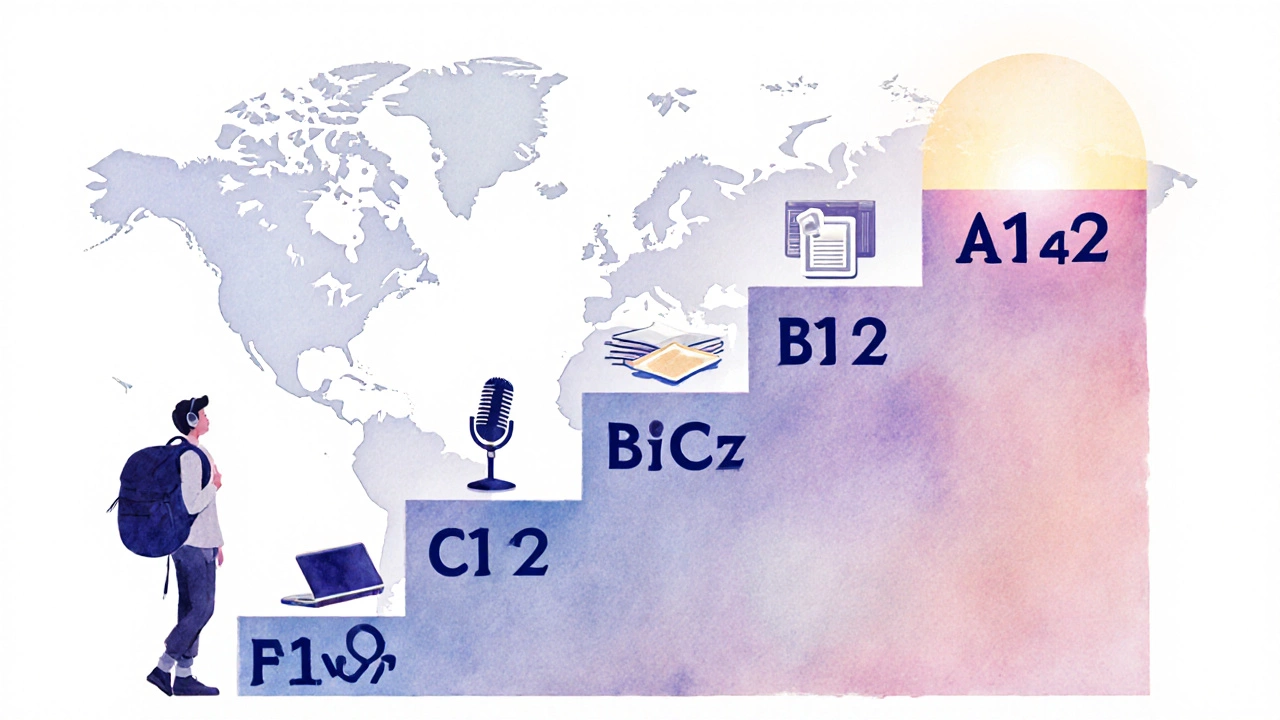
English Fluency Progress Calculator
Assess Your English Fluency Journey
Use this calculator to estimate how long it will take to reach your target fluency level based on your current proficiency and daily study time.
Ever wonder if you can reach true fluency in English without stepping foot in a classroom? The short answer is yes - but you’ll need a plan, the right tools, and a habit that sticks. Below is a step‑by‑step roadmap that turns solo learning into a confident, natural conversation.
What Fluency Actually Means
Fluency is a state where you can understand, speak, read, and write with ease, handling most everyday situations without pausing to think about grammar. It’s not about perfect accents or flawless essays - it’s about fluid, spontaneous communication.
Many learners mistake a high vocabulary score for fluency, but fluency also demands quick recall, natural rhythm, and the ability to respond in real time.
The Core Pillars of Self‑Study
Break your study into five pillars. Treat each like a muscle you train daily.
- Listening practice helps your brain map English sounds to meaning, sharpening comprehension and pronunciation
- Speaking drills force you to produce language on the fly, building confidence and reducing hesitation
- Reading comprehension exposes you to varied syntax and vocabulary, reinforcing patterns you’ll later use when speaking
- Writing exercises let you experiment with structure and receive concrete feedback, even if it’s self‑generated
- Vocabulary expansion feeds the raw material your brain pulls from during conversation
Each pillar feeds the others - stronger listening improves speaking, more reading boosts vocabulary, and writing solidifies grammar.
Designing a Daily Schedule That Sticks
Consistency beats intensity. A 60‑minute routine can be enough if you repeat it every day.
- Morning (10 min): Quick flash‑card review using a spaced‑repetition app like Anki. Focus on 15‑20 words you’ve added the previous week.
- Mid‑day (20 min): Listen to a podcast episode (e.g., "6 Minute English" from BBC). Pause after each segment, jot down unfamiliar phrases, and replay the segment three times.
- Afternoon (15 min): Shadowing - play the same audio, pause, then repeat the sentence aloud trying to mimic rhythm and intonation.
- Evening (15 min): Write a short journal entry about your day, then read it aloud, recording yourself for later comparison.
This template can be tweaked - swap a podcast for a YouTube vlog, or replace journaling with a language‑exchange chat. The key is a balanced blend of input and output.
Free and Paid Resources - A Quick Comparison
| Feature | Free Options | Paid Options |
|---|---|---|
| Listening | YouTube channels (EnglishAddict, BBC Learning) | Audible subscription, ESLPod Premium |
| Vocabulary | Anki, Quizlet (free decks) | Memrise Pro, Rosetta Stone |
| Speaking practice | Tandem, HelloTalk (free tier) | iTalki private lessons, Preply |
| Grammar drills | British Council free activities | Grammarly Premium, Cambridge English Empower |
| Progress tracking | Google Sheets, self‑made checklists | FluentU dashboard, Babbel progress tracker |
Start with the free column; upgrade only when you hit a plateau and need more structured feedback.
Proven Techniques That Accelerate Fluency
These methods have been tested by millions of solo learners.
- Shadowing technique involves mimicking a native speaker word‑for‑word, sharpening pronunciation and rhythm. Do it with news clips or TED talks.
- Spaced repetition optimizes memory by revisiting words just before you’re about to forget them. Anki’s algorithm handles the timing automatically.
- Language exchange pairs you with a native speaker who wants to learn your language, giving both parties authentic conversation time. Schedule 30‑minute video calls two times a week.
- Immersive environment means surrounding yourself with English media - movies, music, subtitles, even phone settings. The brain adapts faster when English becomes background noise.
- Self‑recording lets you catch pronunciation errors and track improvement over weeks. Use your phone’s voice memo app.

Common Pitfalls and How to Dodge Them
Even motivated learners stumble. Here’s what to watch out for.
- Focusing only on grammar. Grammar drills are useful, but without speaking they stay theoretical. Pair each rule with a sentence you actually say.
- Skipping feedback. Self‑assessment is limited. Use apps that give instant correction or occasional tutor sessions for objective input.
- Overloading with resources. It’s tempting to try every podcast, app, and textbook. Choose three core tools and master them before expanding.
- Neglecting consistency. Skipping days creates gaps that lengthen relearning time. Even a 5‑minute speaking mini‑session beats a 60‑minute binge followed by weeks of silence.
Measuring Real Progress
Without numbers you’ll never know if you’re moving forward. Use the CEFR (Common European Framework of Reference for Languages) as a yardstick.
- A1-A2: Can handle basic greetings and simple descriptions.
- B1-B2: Manages everyday conversations, expresses opinions, and understands the main ideas of news articles.
- C1-C2: Speaks fluently on complex topics, uses idiomatic language, and understands nuanced texts.
Take a free online CEFR placement test every two months. If you climb at least one level per six months, you’re on the right track.
Quick Takeaways
- Fluency ≠ perfect grammar; it’s fluid, spontaneous communication.
- Balance input (listening/reading) with output (speaking/writing) daily.
- Use spaced repetition, shadowing, and language exchange as core techniques.
- Start free; upgrade only when you need structured feedback.
- Track progress with CEFR tests and regular self‑recordings.
Can I become fluent in English without a teacher?
Yes. Self‑study works if you combine consistent input, active speaking practice, and periodic feedback. The methods above replicate classroom exposure at a fraction of the cost.
How long does it take to reach fluency on my own?
Time varies by starting level and effort. Most learners who study an hour daily move from A2 to B2 in 12‑18 months. Reaching C1 often requires 2‑3 years of focused practice.
What’s the best way to practice speaking alone?
Shadowing is ideal for solo speakers. Choose a short video, repeat each sentence aloud, and mimic intonation. Record yourself and compare to the original.
Do I need a fancy app for vocabulary?
A simple spaced‑repetition tool like Anki (free) works perfectly. The key is regular review, not the app’s bells and whistles.
How can I stay motivated when I’m studying alone?
Set micro‑goals (e.g., “watch one 5‑minute video without subtitles”) and celebrate each win. Mixing enjoyable content - movies, music, podcasts you love - keeps the process fun.
